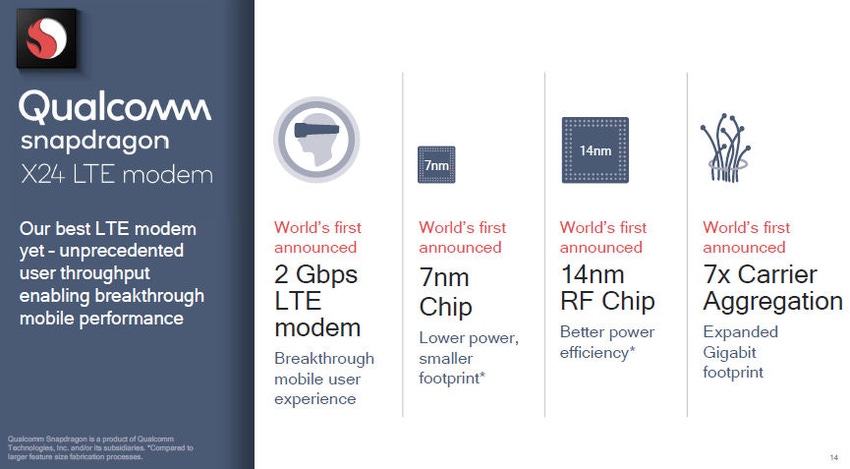Qualcomm claims world’s first 2 Gbps LTE modem
Among the final flurry of announcements to come from Qualcomm’s big 5G day was, curiously enough, a new 4G modem.
February 14, 2018

Among the final flurry of announcements to come from Qualcomm’s big 5G day was, curiously enough, a new 4G modem.
The Snapdragon X24 modem claims to be the first to offer 2 gigabits per second throughput, the first to be made on the 7nm manufacturing process (which enable it to do more with less silicon), and the first to support 7x carrier aggregation. The latter allows seven chunks of spectrum to be used in parallel to allow the aforementioned throughput awesomeness.
“As the world’s first announced Gigabit LTE modem to achieve speeds of up to 2 Gbps, the Snapdragon X24 LTE modem sets a major mobile industry milestone, designed to provide enhanced mobile broadband and deliver an extremely important gigabit coverage layer for commercial 5G networks and mobile devices that are expected to start launching in 2019,” said Serge Willenegger, GM of 4G/5G and Industrial IOT at Qualcomm.
“Further expanding on the use of 4×4 and LAA capability, the Snapdragon X24 packs a powerful array of the most advanced 4G LTE technologies commercially available, helping mobile operators to fully mobilize their spectrum assets and maximize the capacity of their Gigabit LTE networks, and mobile device makers to offer consumers a tangible glimpse of our 5G future.”
This was introduced to the assembled commentators in San Diego last week, but we were required to stay silent on the matter until today for some reason. It serves as a timely reminder of several home truths amid the 5G fervor, as Willeneger alluded to. LTE isn’t going anywhere; it will be the primary vector for mobile data for several years yet and even when 5G starts to ramp up LTE will be the fallback technology on the frequent occasions when you’re out of range of a 5G cell, or a leaf gets in the way of the signal or whatever.
It also serves as a reminder that increased speeds are the least exciting part of 5G. 4G is already able to exceed the speeds most people will ever need on mobile devices, and things like capacity, low-latency, massive IoT, etc are more useful innovations. If the X24 performs as advertised it’s likely to be appearing in mobile devices for many years to come.
Apart from the X24, Qualcomm had kept three more announcements up its sleeve until today. One is a new software development kit designed to support the commercialisation of IoT. And then there’s the introduction of Qualcomm Wireless Edge Services, which again is aimed at the IoT ecosystem but this time with the aim of helping with the provision, connection and management of IoT devices. The last PR just reflected on the 5G day and summarised all the good things Qualcomm is doing in the wide, wide world of 5G.
As we’ve written previously this whole exercise seems to have been designed to not just demonstrate Qualcomm’s 5G modem leadership, but also to show what a good job it’s doing of diversifying into the other opportunities expected to be created by 5G, such as IoT, VR and connected cars. It’s especially important for Qualcomm’s current senior management that its investors see this as evidence of how their interests would be best served by keeping the company free from the clutches of Broadcom.
About the Author(s)
You May Also Like








.png?width=300&auto=webp&quality=80&disable=upscale)


_1.jpg?width=300&auto=webp&quality=80&disable=upscale)


.png?width=800&auto=webp&quality=80&disable=upscale)